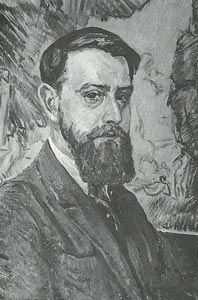
Adrien Hébert, self-portrait, c. 1923
BIOGRAPHY
A painter, draughtsman, printmaker, illustrator, Adrien Hébert, son of noted sculptor Louis-Philippe Hébert and brother of Henri Hébert, was born in Paris in 1890 while his father worked on the bronze castings of the historical monuments. He studied with Edmond Dyonnet, J.C. Franchère at the Council of arts and manufactures in Montreal in 1904-06, with William Brymner at the Art Association of Montreal in 1910-11 and at the École des beaux-arts in Paris in 1911-13. He taught for the Montreal Catholic School Commission from 1917 to 1954 and at the council of Arts and Manufactures in Montreal in 1923. He lived in Paris in 1890-94, 1897-1902 and 1922-23.
A contributor to the avant-garde arts publication Le Nigog since 1918, Hébert was part of a Montreal artistic elite that battled for the tolerance of current artistic movements. “Having accepted modern life”, he said, “it is only logical to embrace modern subjects in art”. He died in Montreal in 1967.
SUBJECT
For Adrien Hébert the busy port’s complex array of lines shapes, colours was a thing of beauty, a worthy subject for art and a welcome symbol of industrial progress. “Listen to its music”, he wrote, “the great symphony created the loading and unloading of grain, the banging of the steel cables, the noise of the winches and the chatter between tugboasts and ocean liners”. He also liked to paint Sainte-Catherine Street with its buildings, pedestrians and automobiles.
TECHNIQUE/MEDIUM
Adrien Hébert’s paintings appear to combine a certain Impressionist flavor wedded to a forthright Canadian approach to actuality.
EXIBITIONS
Adrien Hébert exhibited his work at the Montreal Museum of Fine Arts in 1949.
COLLECTIONS
Adrien Hébert’s workis included in the following collections: The National Gallery of Canada, Le Havre Museum, France, The Montreal Museum of Fine Arts, The Museum of the Privince of Quebec, The Museum at Nimes, France, The International Business Machines Corporation, the Art Association of Montreal and in many private collections.
AWARDS
In 1932 he was elected an Associate of Royal Canadian Academy and in 1936 won the Jessie Dow prize for his painting “Winter Morning” (a view of the old Montreal Court House grounds with the Nelson Monument, Bonsecours Market and grain elevators in the background). In 1940 he was awarded the Jessie Dow price for the second time.
Source: Anne Newlands, Canadian art from its beginnings to 2000, Firefly, 2000 ; Catalogue of the National Gallery of Canada, Canadian art, volume two/G-K, Ottawa, 1994